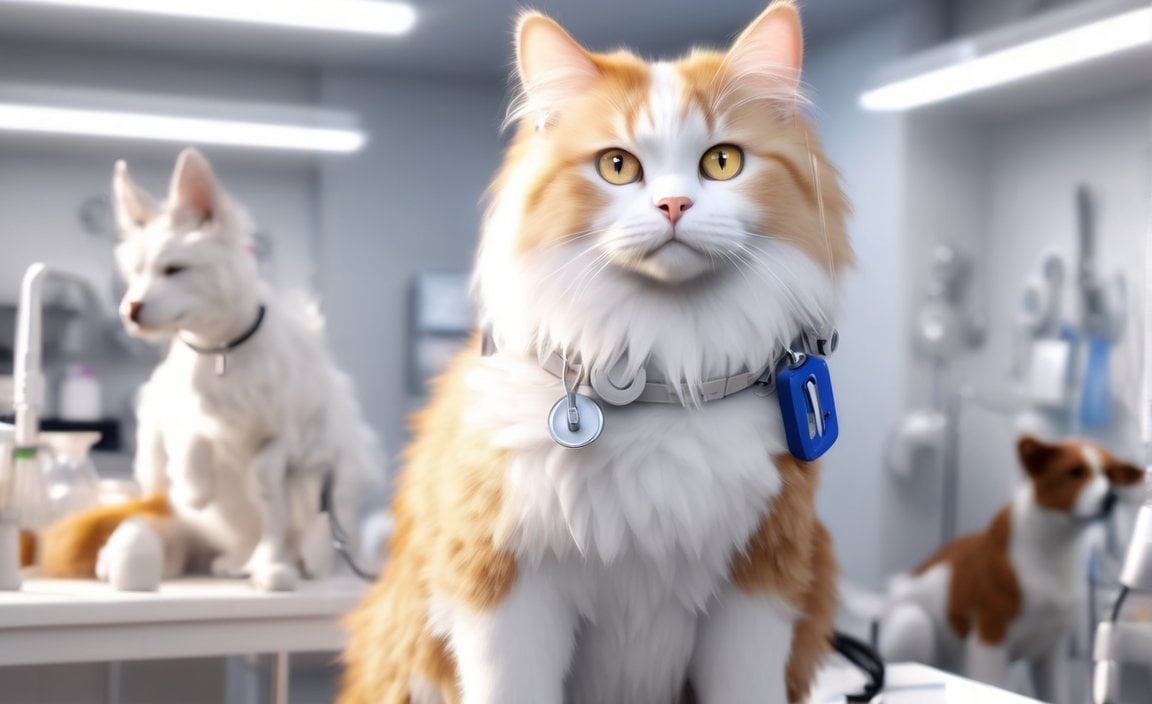If you’ve ever wondered what it truly takes to be a veterinarian and the realities of their day-to-day work, then look no further. In this article, titled “The Reality of Veterinary Practice: 5 Key Facts,” we delve into the essential aspects of the veterinary profession that go beyond just treating animals. From the importance of preventive care to the challenges of client communication, we explore the diverse skills and experiences that make a successful veterinarian. So, if you’re interested in gaining insights into what it means to be a veterinarian, keep reading to discover these key facts.

Key Takeaways:
- Veterinarians develop a deep love for animals at a young age.
- Veterinarians undergo rigorous education and training to acquire necessary skills.
- Vets deal with emotional and demanding pet owners on a daily basis.
- Veterinarians often work long hours, including on weekends.
- When they finish their studies, veterinarians enter a job market overloaded with high-demand positions.
These key facts highlight the dedication, challenges, and preparation required in the field of veterinary medicine.
5 Facts About Being a Veterinarian
Being a veterinarian is a rewarding yet demanding profession that requires a deep love for animals and a commitment to their well-being. Here are five key facts that shed light on the reality of veterinary practice:
1. A Passion for Animals Fuels the Journey
From a young age, veterinarians cultivate a deep love and appreciation for our furry friends. Many are drawn to the profession because of their innate desire to help animals and make a positive impact on their lives. This passion drives veterinarians to pursue a career centered around animal welfare and healthcare.
2. Rigorous Training and Education Build Essential Skills
Becoming a veterinarian involves a rigorous journey of education and training. After completing a bachelor’s degree, aspiring veterinarians must earn a Doctor of Veterinary Medicine (DVM) degree, which typically takes four years. During this time, they gain a comprehensive understanding of anatomy, physiology, pharmacology, surgery, diagnostics, and more. This extensive training equips veterinarians with the necessary knowledge and skills to provide optimal care to their patients.
3. Compassion Extends Beyond Animals to Pet Owners
While veterinarians primarily focus on the well-being of animals, they also frequently interact with pet owners. Dealing with emotional and sometimes demanding pet owners is an integral part of the job. Veterinarians must navigate these interactions with empathy and understanding, providing support and guidance during difficult times.
4. Long Hours and Weekend Commitments
Veterinarians often work long hours, including weekends and holidays. Animals require care around the clock, and emergencies can arise at any time. From conducting surgeries to handling routine check-ups, veterinarians dedicate themselves to providing the best possible care to their patients, regardless of the time of day.
5. A Competitive Job Market with High Demand
Upon completing their studies, veterinarians enter a job market that is often saturated with high-demand positions. As the number of pets and their owners continues to grow, the need for veterinary professionals also increases. However, finding employment in certain areas or specialized fields may still pose challenges. Despite these challenges, the demand for veterinarians reflects the importance of animal healthcare and the role they play in our society.
In conclusion, being a veterinarian requires passion, dedication, and a strong sense of empathy. By understanding and appreciating these facts, individuals can gain a deeper appreciation for the vital role veterinarians play in ensuring the health and well-being of our beloved pets.
Here are 5 captivating facts about therapy dogs that you didn’t know. Did you know that therapy dogs can help reduce anxiety and stress in individuals? Find out more about these amazing companions here.
Discover 5 fascinating facts about veterinarians and their work. Did you know that veterinarians undergo rigorous training to ensure they can provide the best care for animals? Learn more about the world of veterinarians here.
Uncover 5 intriguing facts about veterinary science. Did you know that veterinary science encompasses a wide range of disciplines, including microbiology, pharmacology, and surgical techniques? Expand your knowledge about this field here.
Explore 5 interesting facts about a veterinarian’s profession. Did you know that veterinarians often work in diverse settings, from small animal clinics to wildlife sanctuaries? Delve into the world of veterinary medicine here.
You Have To Be Good With People
As a veterinarian, you might expect that your main focus would be on animals. And while it’s true that caring for our furry friends is a crucial part of the job, there’s another aspect that often goes unnoticed: the importance of being good with people. Yes, you read that right. To be a successful veterinarian, you have to be good with people as much as you are with animals.
Understanding the Human-Animal Bond
One of the key reasons why you have to be good with people as a veterinarian is that you are not just treating animals, but also dealing with the people who care for them. Pet owners form a significant part of your clientele, and their emotions, concerns, and needs matter. By developing strong communication and interpersonal skills, you can effectively connect with pet owners and empathize with their worries. This allows you to not only address their concerns but also educate and guide them in providing the best care for their beloved companions.
Navigating Emotional Challenges
When it comes to veterinary practice, it’s not always smooth sailing. Alongside the joy of healing, there are emotional challenges that can take a toll on your well-being. You have to be good with people to navigate these challenges with empathy and resilience. From delivering difficult diagnoses to euthanasia discussions, you’ll come face-to-face with the raw emotions that accompany pet ownership. By being a compassionate and understanding presence, you can help pet owners through these difficult times, providing them with the support they need.
Collaborating with a Team
Veterinary practice thrives on teamwork and collaboration. You won’t be operating in isolation; you’ll be working with a team of dedicated professionals, including veterinary technicians, assistants, and office staff. You have to be good with people to foster strong relationships with your colleagues, as teamwork is essential for providing comprehensive care. Through effective communication and cooperation, you can ensure that each patient receives the best possible treatment and that the clinic runs smoothly.
Educating and Guiding Clients
Providing exceptional veterinary care goes beyond clinical expertise; it also involves educating and guiding pet owners. You have to be good with people to effectively communicate veterinary knowledge in a way that is understandable and relatable. By explaining diagnoses, treatment plans, and preventive care measures clearly and patiently, you empower pet owners to make informed decisions regarding their pets’ well-being. This education helps create a strong foundation for a long-lasting and trusting client-veterinarian relationship.
Strengthening the Veterinary Profession
As a veterinarian, you have to be good with people to strengthen and advance the veterinary profession as a whole. By being a positive ambassador for your profession and engaging with the community, you can raise awareness about veterinary medicine and the importance of animal welfare. Whether it’s through public speaking engagements, community outreach programs, or sharing your expertise online, you can contribute to the growth and development of the field.
Key Takeaways:
- Being a veterinarian requires not only a love for animals but also excellent people skills.
- Effective communication and empathy are essential in building strong relationships with pet owners.
- Being good with people helps in navigating the emotional challenges of the profession with compassion and resilience.
- Collaboration and teamwork are crucial for providing comprehensive care in a veterinary clinic.
- Educating and guiding clients enables them to make informed decisions about their pets’ well-being and fosters a trusting client-veterinarian relationship.
- Engaging with the community helps to strengthen and advance the veterinary profession.
Citation:
– Career Trend article
– Pet Keen article
The Vast Majority of Vets Are Women
Women have been making significant strides in the field of veterinary medicine, with a growing number of them pursuing careers as veterinarians. In fact, a study conducted in 2020 found that approximately 82% of veterinary students were women[^1^]. This trend is not only changing the face of the profession but also brings unique opportunities and challenges. Here are five key facts that shed light on the reality of veterinary practice, where the vast majority of vets are women.
Fact 1: The Rising Representation of Women in Veterinary Medicine
Over the years, the number of women in the veterinary field has seen a remarkable increase. According to statistics, the share of women in veterinary medicine has grown by 7% in the past 16 years, reaching a total of 86,341 female veterinary workers in 2016[^1^]. Factors contributing to this growth include more women pursuing higher education and graduating with bachelor’s degrees. In fact, women have consistently represented about 57% of the enrollment at U.S. colleges[^1^]. This surge in representation reflects the dedication and passion that women bring to the field of veterinary medicine.
Fact 2: Gender Disparities and Discrimination Persist
Despite the significant progress made in women’s representation in veterinary medicine, gender disparities and discrimination still exist in certain areas. Research indicates that women veterinarians outnumber men; however, they occupy fewer positions in the higher reaches of the profession. In veterinary specialties, occupational segregation by gender can be observed, with differences in the likelihood of successfully matching into certain residency programs[^2^]. These gender-based challenges hinder women’s progression and limit their earning potential.
Fact 3: Factors Contributing to the Feminization of Veterinary Medicine
Several factors have contributed to the feminization of veterinary medicine. One important factor is the elimination of gender-based discrimination during the admission process to veterinary schools, allowing more women to pursue this career path[^3^]. Additionally, the decline in male applicants and the subsequent increase in female applicants have led to a greater proportion of women in the profession[^3^]. Efforts such as the Higher Education Act of 1973 have played a role in promoting gender diversity in veterinary medicine[^3^].
Fact 4: Economic Implications and Earnings Disparity
It is worth noting that despite the increasing number of women in veterinary medicine, earnings disparity between male and female veterinarians persists. A study found that women veterinarians tend to earn less than their male counterparts[^4^]. Women are also more likely to be employed as assistants rather than in higher-level positions such as directors or partners[^4^]. Addressing these economic implications and promoting gender equity in earning potential are essential for the advancement of women in veterinary practice.
Fact 5: Moving Towards a More Inclusive Profession
The increasing presence of women in veterinary medicine brings both opportunities and challenges. While the field is becoming more inclusive, efforts are still needed to address gender disparities, discrimination, and inequities in earning potential. By overcoming these challenges, we can create a profession that values the contributions of all its members, regardless of gender.
Key Takeaways:
- The number of women in veterinary medicine has significantly increased over the years, with approximately 82% of veterinary students being women.
- Despite this growth, gender disparities and discrimination persist, limiting women’s advancement in certain areas of veterinary practice.
- Factors such as the elimination of gender-based discrimination and a decline in male applicants have contributed to the feminization of veterinary medicine.
- Women veterinarians tend to earn less than men, and there is a limited representation of women in higher-level positions.
- Efforts to promote gender equity and address these challenges are crucial for creating a more inclusive and thriving veterinary profession.
Sources:
[^1^]: The VET Recruiter. Veterinary Demographics: Women Veterinarians.
[^2^]: ScienceDaily. Gender discrimination holding women back in veterinary practice.
[^3^]: Cornell Chronicle. Why are women crowding into schools of veterinary medicine.
[^4^]: Cornell Chronicle. Women veterinarians earn less than men, study finds.

FAQ
Q1: What do veterinarians do?
A1: Veterinarians provide medical care and treatment to animals, including diagnosing illnesses, performing surgeries, administering medications, and advising on preventive care.
Q2: Do you need high grades to be a veterinarian?
A2: While high grades can be beneficial, they are not the only requirement for becoming a veterinarian. Admissions to veterinary schools also consider other factors such as experience, extracurricular activities, and letters of recommendation.
Q3: Do you have to be good with people to be a veterinarian?
A3: Yes, being good with people is an essential skill for veterinarians. They need to effectively communicate with pet owners, explain diagnoses and treatment options, and provide education about animal care.
Q4: Is it true that the vast majority of vets are women?
A4: Yes, the field of veterinary medicine has seen a significant increase in the number of women practicing as veterinarians. In recent years, women have outnumbered men in veterinary schools and have become the majority in the profession.
Q5: What are the key facts about being a veterinarian?
A5: The key facts about being a veterinarian include the rigorous education and training required, the long working hours and demanding pet owners, the high levels of stress and low job satisfaction reported, and the availability of various specialties and work settings within the field.
- Guatemala vs. Costa Rica: Plan Your Trip Smartly - April 16, 2025
- Master Types of Pumps: Ultimate Guide to Selection - April 16, 2025
- Unlock Types of Makeup Secrets: Master Any Look Now - April 16, 2025
















